- Clone
- 1D4B (See other available formats)
- Regulatory Status
- RUO
- Other Names
- Lysosome-associated membrane glycoprotein 1, lysosomal membrane glycoprotein 1, CD107 antigen-like family member A, lysosome-associated membrane protein 1
- Isotype
- Rat IgG2a, κ
- Ave. Rating
- Submit a Review
- Product Citations
- publications
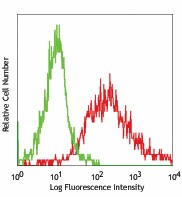
-

Thioglycollate-elicited BALB/c mouse peritoneal macrophages stained with 1D4B PE
| Cat # | Size | Price | Save |
|---|---|---|---|
| 121611 | 50 µg | ¥21,720 | |
| 121612 | 200 µg | ¥57,500 |
CD107a, also known as Lysosome-Associated Membrane Protein 1 (LAMP-1) or LGP-120, is a 110-140 kD type I membrane glycoprotein. Mature CD107a is heavily glycosylated from a 40 kD core protein. This molecule is located on the luminal side of lysosomes. Upon activation, CD107a is transferred to the cell membrane surface of activated platelets, activated lymphocytes, macrophages, epithelial cells, endothelial cells, and some tumor cells. CD107a has been suggested to play a role in the protection of lysosomal membrane from lysosomal hydrolases which is involved in cell adhesion and regulation of tumor metastasis, and mediates autoimmune disease progression. CD107a is a ligand for galaptin and E-selectin. Surface expression of LAMP-1 has been shown to correlate with CD8+ T cell and NK cell cytotoxicity.
Product DetailsProduct Details
- Verified Reactivity
- Mouse
- Antibody Type
- Monoclonal
- Host Species
- Rat
- Immunogen
- This monoclonal antibody was raised against NIH/3T3 mouse embryonic fibroblast tissue culture cell membranes. It has been mapped to the N-terminus of LAMP-1.
- Formulation
- Phosphate-buffered solution, pH 7.2, containing 0.09% sodium azide.
- Preparation
- The antibody was purified by affinity chromatography, and conjugated with PE under optimal conditions.
- Concentration
- 0.2 mg/ml
- Storage & Handling
- The antibody solution should be stored undiluted between 2°C and 8°C, and protected from prolonged exposure to light. Do not freeze.
- Application
-
FC - Quality tested
- Recommended Usage
-
Each lot of this antibody is quality control tested by immunofluorescent staining with flow cytometric analysis. For flow cytometric staining, the suggested use of this reagent is ≤0.25 µg per million cells in 100 µl volume. It is recommended that the reagent be titrated for optimal performance for each application.
- Excitation Laser
-
Blue Laser (488 nm)
Green Laser (532 nm)/Yellow-Green Laser (561 nm)
- Product Citations
-
- RRID
-
AB_1732051 (BioLegend Cat. No. 121611)
AB_1732051 (BioLegend Cat. No. 121612)
Antigen Details
- Structure
- LAMP-1 is a 406 amino acid protein with a molecular mass of 44 kD.
- Gene ID
- 16783 View all products for this Gene ID
- UniProt
- View information about CD107a on UniProt.org
Related Pages & Pathways
Pages
Related FAQs
- What type of PE do you use in your conjugates?
- We use R-PE in our conjugates.
Other Formats
View All CD107a Reagents Request Custom ConjugationCustomers Also Purchased
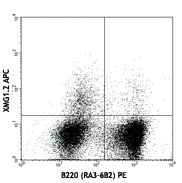
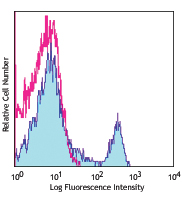
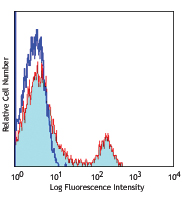
Compare Data Across All Formats
This data display is provided for general comparisons between formats.
Your actual data may vary due to variations in samples, target cells, instruments and their settings, staining conditions, and other factors.
If you need assistance with selecting the best format contact our expert technical support team.
-
PE/Dazzle™ 594 anti-mouse CD107a (LAMP-1)
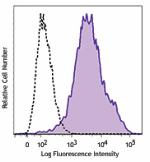
Thioglycollate-elicited Balb/c mouse peritoneal macrophages ... -
PE anti-mouse CD107a (LAMP-1)

Thioglycollate-elicited BALB/c mouse peritoneal macrophages ... -
Purified anti-mouse CD107a (LAMP-1)
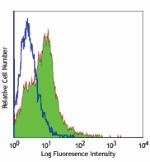
Thioglycollate-elicited BALB/c mouse peritoneal macrophages ... 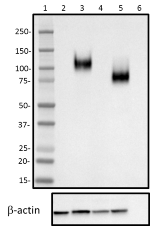
Western blot of purified anti-LAMP-1 antibody (clone 1D4B). ... -
Biotin anti-mouse CD107a (LAMP-1)
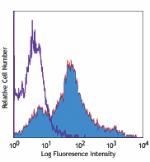
Thioglycollate-elicited BALB/c mouse peritoneal macrophages ... -
FITC anti-mouse CD107a (LAMP-1)
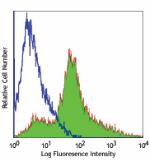
Thioglycollate-elicited BALB/c mouse peritoneal macrophages ... -
Alexa Fluor® 488 anti-mouse CD107a (LAMP-1)
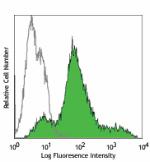
Thioglycollate-elicited BALB/c mouse peritoneal macrophages ... -
Alexa Fluor® 647 anti-mouse CD107a (LAMP-1)
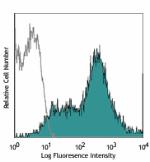
Thioglycollate-elicited BALB/c mouse peritoneal macrophages ... -
APC anti-mouse CD107a (LAMP-1)
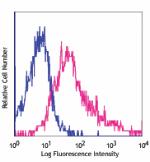
Thioglycollate-elicited Balb/c peritoneal macrophages staine... -
APC/Cyanine7 anti-mouse CD107a (LAMP-1)
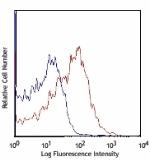
Thioglycollate-elicited BALB/c peritoneal macrophages staine... -
Brilliant Violet 421™ anti-mouse CD107a (LAMP-1)
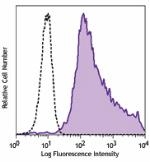
Thiogylcollate-elicited BALB/c mouse peritoneal macrophages ... -
PE/Cyanine7 anti-mouse CD107a (LAMP-1)
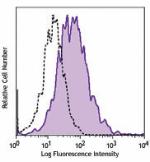
Thioglycollate-elicited BALB/c mouse peritoneal macrophages ... 
Thioglycollate-elicited BALB/c mouse peritoneal macrophages ... -
Alexa Fluor® 594 anti-mouse CD107a (LAMP-1)
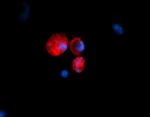
Thioglycolate-elicited BALB/c mouse peritoneal macrophages w... -
PerCP/Cyanine5.5 anti-mouse CD107a (LAMP-1)
_Antibody_FC_032516.jpg&Width=150&altFmImage_path=&Crop=5)
Thioglycollate-elicited Balb/c mouse peritoneal macrophages ... -
Alexa Fluor® 700 anti-mouse CD107a (LAMP-1)

Thioglycollate-elicited BALB/c mouse peritoneal macrophages ... -
Brilliant Violet 510™ anti-mouse CD107a (LAMP-1)
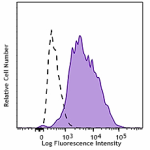
Thiogylcollate-elicited BALB/c mouse peritoneal macrophages ... -
Brilliant Violet 711™ anti-mouse CD107a (LAMP-1)

Thioglycollate-elicited BALB/c mouse peritoneal macrophages ... -
APC/Fire™ 750 anti-mouse CD107a (LAMP-1)

Thioglycollate-elicited Balb/c mouse peritoneal macrophages ... -
TotalSeq™-A0905 anti-mouse CD107a (LAMP-1)
-
TotalSeq™-C0905 anti-mouse CD107a (LAMP-1)
-
TotalSeq™-B0905 anti-mouse CD107a (LAMP-1)
-
Brilliant Violet 785™ anti-mouse CD107a (LAMP-1)

C57BL/6 splenocytes were stained with anti-mouse F4/80 FITC ... -
Spark Red™ 718 anti-mouse CD107a (LAMP-1) (Flexi-Fluor™)
-
Brilliant Violet 605™ anti-mouse CD107a (LAMP-1)

Thioglycollate-elicited BALB/c mouse peritoneal macrophages ... -
Brilliant Violet 650™ anti-mouse CD107a (LAMP-1)

Thioglycollate-elicited BALB/c mouse peritoneal macrophages ... -
Spark Blue™ 574 anti-mouse CD107a (LAMP-1) (Flexi-Fluor™)
-
Spark Blue™ 550 anti-mouse CD107a (LAMP-1) (Flexi-Fluor™)










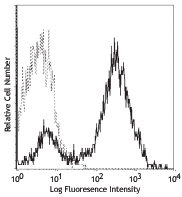



Follow Us